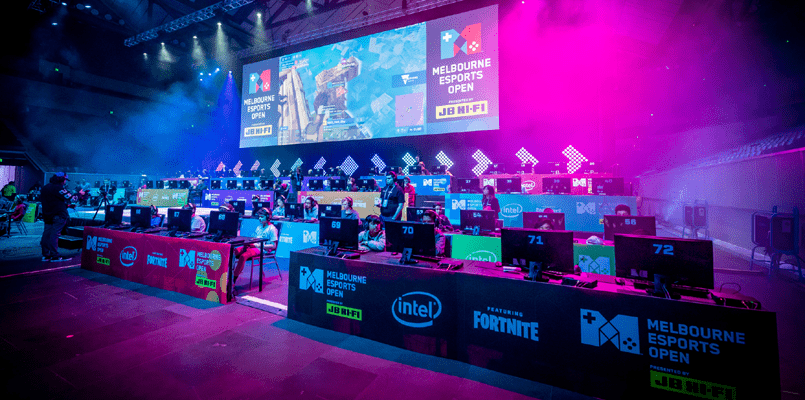
Esports Trade Association President John Davidson talks connecting with the female audience and possible growth opportunities
June 4, 2020Esports are all the rage right now and Esports Trade Association President John Davidson has been behind the scenes helping to ensure esports are sustainable for years to come. John has a background in professional skateboard culture and uses that knowledge of the brand ambassador mentality to help him in his esports career. He currently works as the Director of Business Development for Product Resource Group, which is the world’s leading provider of event technology, and previously led non-endemic partnerships and the esports strategy for GameStop, the world’s largest specialty gaming retailer. To say the least, he knows a thing or two about the industry. I sat down with him virtually to discuss some of the questions I had about the esports industry.
1. Why are professional esports dominated by men and how can the industry be more inclusive to the female esports players? Do you think there is a systemic issue in esports that excludes women or have the recruiting techniques not been successful in attracting female gamers?
When you look at marketing and development of video games over the years, it has been very much targeted towards the male demographic. There has been a perception that females are not interested in gaming, but fortunately the falsehood of that narrative has become more clear over recent years. Esports is a very young industry compared to traditional sports. This makes me optimistic because it is easier to change practices of a newer entity than one that has done things a certain way for 100 years; quite literally for leagues like the NFL. Esports has an opportunity to be an agent of change in a variety of ways, from paying college players, to how media is consumed, to becoming more inclusive. I think it’s difficult for most people to have their minds open to doing something that has never been done before. As more women compete at the professional level, it shows girls (and their parents) that pursuing a career in esports is possible, enabling them to pursue that path, where previously they may have never even considered the possibility. Pros like Geguri in Overwatch League and Chequira Evans in the NBA2K League are blazing the path for the next generation of female gamers. The community is very aware of this issue and I see active efforts by the industry to enable the space to become more diverse.
2. Statistics show that the esports fanbase is approximately 25% female. What new tactics do you see esports using to expand their fanbase to become more diverse?
The main thing is providing more opportunities to compete at both professional and amateur levels. At the professional level, this is happening by allowing both males and females to compete in the same league and also hosting female specific tournaments. The female specific tournaments enable more women to play and I hope to see more diversity in the larger leagues as more women pursue their passion of competitive gaming, providing more opportunities to play side-by-side their male counterparts. At the amateur level, you have companies like Mission Control (https://missioncontrol.gg) building platforms to foster community and enable rec league esports, which are open to both males and females. I believe grassroots platforms like these will greatly empower the diversity of competitors in our industry.
3. Do you believe the COVID-19 pandemic has increased viewership for esports? And what tactics are esports leagues and teams using now that you believe will stick around post-pandemic?
Statistics show that the COVID crisis has greatly increased viewership online for gaming as a whole, both esports and non-competitive games. Video game publishers and streaming platforms have greatly benefited from the shutdown, but individual teams, which have much more challenging monetization models, have missed out on revenue and fan engagement from live events. Probably the biggest benefit to the industry has been the visibility to the non-gaming world that esports has received from traditional sports utilizing esports to maintain interest and attract new fans during a time when they can’t host games. The esports industry has not so much employed specific tactics as much as online competition and viewership is simply a natural part of the industry. Esports was born and bred online and has only recently really focused on live events and geographically located teams. I think the main tactic that will take hold is traditional sports athletes continuing to interact with the gaming community, streaming more often and participating in events, from video game releases to influencer-focused tournaments. We’ve seen this happen a little bit with athletes like JuJu Smith-Schuster, De’Aaron Fox, and Karl-Anthony Towns. It’s a great way for athletes to build their personal brand and I believe teams and leagues should enable this to increase relatability [sic] with players of traditional leagues to create new fans.
4. If you had a magic wand, what is one thing in the esports realm you would want to overhaul?
I would provide better data for each esports video game to brands and agencies. We often discuss esports as one thing, when it is actually a culmination of about 20 different video games that all have unique follower demographics. We don’t lump all traditional sports enthusiasts together when we talk about viewership or the size of the audience; we segment them by leagues. The demographics of traditional sports leagues are well known, enabling sponsors to properly segment and target. Currently, sponsors are evaluating their investments based on the amount of followers or viewership a team or league commands. They do not currently have the information to make these decisions based on demographics. A brand could make a large sponsorship investment into a league with a large following, not receive a strong ROI and believe that the whole industry is a bad investment. It could very well be the case that they simply didn’t successfully target the audience that would respond well to their brand. I believe this happens often and more detailed demographic information will enable brands to make more informed sponsorship decisions, resulting in better ROI and more dollars coming into the space to enable our community to do more of what we love.
5. What is some advice you would give people interested in breaking into the business-side of esports?
To experienced business professionals, I would say approach people within the esports industry with humility, listening and learning. There are a lot of really great people in this space who are willing to get on a phone call and answer questions. Once you listen and learn, you can then provide your expertise or perspective on things, but if you come in telling people what to do or as an expert without putting in the time to do your due diligence, the industry will not respond the way you’d hope. For high school or college kids, I encourage you to volunteer at local events (once they come back, of course). Build personal relationships, gain experience by happily assisting with any tasks a team needs help with. This will give you much-needed experience and open your eyes to the day-to-day tasks of roles that you’re familiar with, and jobs that you didn’t know existed. A lot of business comes down to how enjoyable you are to hang out with. Hiring is an expensive investment, which is why companies often hire people they already know. Work hard, have a good attitude, build authentic relationships without an agenda and keep an eye out for opportunity.
6. Do you think it is harmful to esports for people to use the term “real sports” when discussing traditional professional sports to differentiate from esports?
Not really. I rarely hear people use the term “real sports” with any sort of malice. It’s simply the result of not being sure how to compare esports and traditional sports; which is complicated. I actually prefer the term “competitive gaming” over “esports”, because I think it’s a more clear description. The term “esports” naturally starts a debate over whether it’s a “real sport”, which is subjective based on your definition. Regardless, esports requires skill and practice, and most importantly, it is extremely entertaining for hundreds of millions of people around the world, who are no longer watching traditional sports or tv. Brands are desperate to reach young people and esports gives them great opportunities to do so.
7. What is one thing you would like the non-esports watching world to know about esports?
The one thing I’d like the non-esports watching world to know is that gamers don’t just want to do the virtual version of what older people enjoy. Just because you enjoy baseball, that doesn’t necessarily mean you’ll engage youth by putting on video game baseball tournaments. The most popular competitive video games are not tied to traditional sports. Instead, I’d encourage you to go to the gaming community, take the time to understand what they enjoy and why, then help enable them to do more of that by integrating into their world. Learn to play by their rules, rather than trying to force yours onto them.
To learn more about the Esports Trade Association, head over to their website and read more about their mission and what they are doing to help the esports industry.
You can find the original article here: Esports Trade Association President John Davidson talks connecting with the female audience and possible growth opportunities
Categorized in: Esports News, ESTA News, In the News




